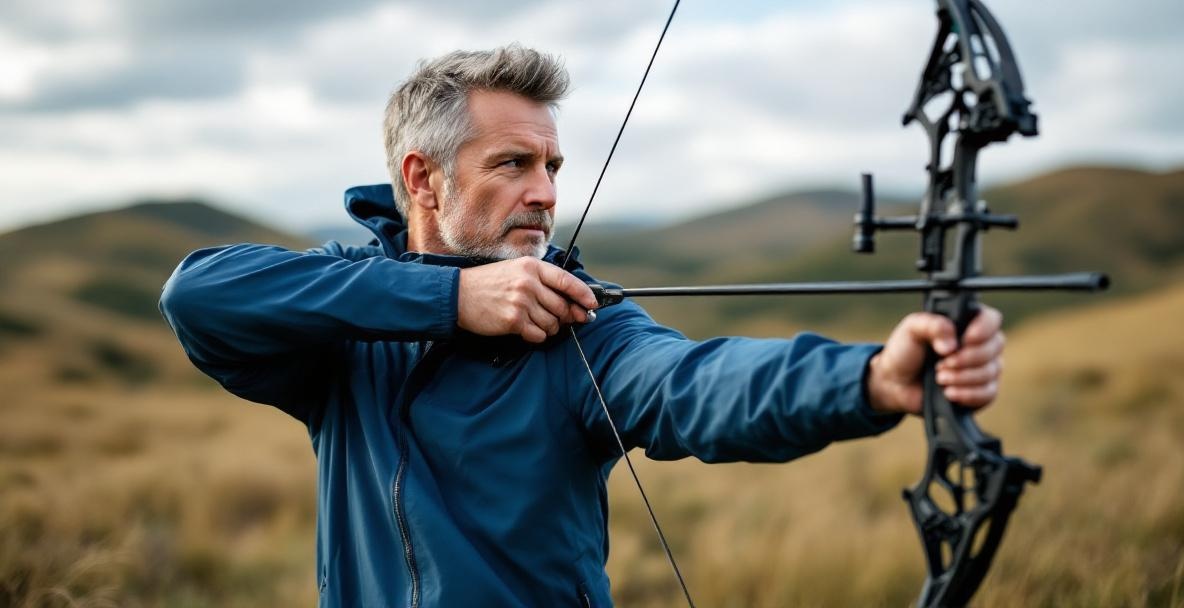Tackling the Windy Challenge for Archers

Every archer has faced that sting when a perfect form and true aim suddenly get thrown off by a quick gust. That unexpected wind can turn a sure shot into a miss in just a second, testing your skill and patience whether you're at the range or out in the field.
Wind does more than simply knock arrows off their path. It can shake your confidence in an instant. At OneX Archery, we have seen skilled shooters lose focus as soon as even a small breeze shows up. When gusts start to play around, keeping your shots steady feels almost impossible without adjusting your technique and gear. In a competition, one wild arrow can be the difference between standing on the podium and going home empty-handed.
Wind can do more than veer your arrow off course – it can unsettle even the best archer.
Mastering the wind means turning that invisible challenge into a factor you can plan for and beat.
The Science of Wind Interference
Understanding how wind messes with your arrow starts with a bit of basic physics. When you fire an arrow, it meets drag from the air that increases with its speed. If a crosswind hits the arrow, uneven pressure pushes it off course. A small drift at 20 yards can turn into a big miss at 50 or 70 yards.
The speed of your arrow matters a lot. A faster arrow spends less time in the air, so the wind has less chance to push it around. But keep in mind that lighter arrows-even though they zoom by quickly-can sometimes suffer more wind drift than heavier ones that carry extra momentum. It is all about finding the right balance and making smart adjustments.
Arrow Weight and Wind Drift – A Quick Look
| Arrow Type | Typical Grain Per Inch | Average Speed (fps) | Wind Drift at 40 yd (10 mph crosswind) | Ideal Use Situation |
|---|---|---|---|---|
| Lightweight Carbon | 5.5 – 7.0 | 290 – 320 | High (≈ 6-8") | 3-D shoots, calm conditions |
| Mid-weight All-Purpose | 7.0 – 8.5 | 275 – 300 | Moderate (≈ 4-6") | General target & field |
| Heavy Micro-Diameter | 8.5 – 10.5 | 255 – 285 | Low (≈ 2-4") | Windy outdoor rounds, hunting |
How a Steady Setup Makes a Difference
Your bow’s steadiness can make all the difference when the wind is in play. A light, nimble setup might feel great until a gust makes it wobble. That’s why having the right stabilizer weights is so important. When you add them in the right spots, you boost your consistency and keep your shots on track even when the wind picks up.
At OneX Archery, our carefully crafted stabilizer weights are designed to tackle these windy challenges head-on. Using our stainless steel weights improves your bow’s steadiness so that sudden gusts have less impact, all while keeping the responsiveness you need for a sharp shot. The smart, stackable design lets you adjust for blustery days or lighten up when the wind dies down.
Using our stainless steel weights gives you extra resistance against gusts and keeps your bow responsive for a true shot.
Getting a steady shot on windy days isn’t only about gear; it’s also about a balanced approach that covers equipment tweaks, technique changes, and even mental prep. In this guide, we share real strategies that help archers take control of the wind and turn it into an advantage.
Grasping Wind Behavior – The Essentials

Wind is the trickiest part of archery and can flip a sure shot into a miss in a heartbeat. At OneX Archery, we’ve seen how even a gentle breeze can change an arrow’s path. Knowing how wind affects your arrow is key to hitting your target every time. Simply put, wind pushes against your arrow and sends it off track. Learning to read these patterns comes from mixing real knowledge with hands-on practice.
Spotting Wind Direction and Speed
Getting a good read on the wind is a must for outdoor archery success. Start by taking a look at nature around you: notice how the grass bends, see the tree branches sway, or observe the flutter of nearby flags. A soft rustle in the grass often means winds of about 3-5 mph, while trees that begin to sway might signal winds closer to 8-12 mph. These simple clues give you an instant idea of the wind without needing fancy tools.
If you want more precise details, a portable wind meter (an anemometer) can give you accurate readings of wind speed and direction. These handy devices are affordable and very useful for competition shooting. But remember, numbers alone do not tell the whole story-you need to know what they mean for your shot. At OneX Archery, we suggest practicing in varied wind conditions so you develop a natural feel for how different gusts affect your arrow.
Reading the wind means noticing both the usual patterns and the local quirks of your area. Look at how hills, buildings, or tree lines steer the wind into channels or create sheltered pockets. The wind rarely blows in a straight line; it swirls and shifts throughout the day. Once you learn these patterns, you’ll be better able to tweak your aim and decide the best time to shoot.
Different Kinds of Wind and What They Do
Crosswinds can be a real headache. They blow across your shot, pushing your arrow sideways. Even a 10 mph crosswind can nudge an arrow several inches off target at 40 yards, and the miss grows with distance. How you handle this depends on your gear. For example, compound archers might adjust your sight, while traditional shooters might change their anchor. Using stabilizer weights can help keep your bow steady when you need to aim off-center.
Crosswinds challenge your aim by pushing arrows sideways and making every shot unpredictable.
Wind Type and How to Adjust – A Quick Guide
| Wind Type | Effect on Arrow | Adjustment Tip | Miss Risk |
|---|---|---|---|
| Crosswind (Perpendicular) | Lateral push | Aim into wind / adjust sight | High |
| Headwind (Toward Archer) | Increased drag, lower impact point | Aim slightly higher | Medium |
| Tailwind (Away from Archer) | Reduced drag, higher impact point | Aim slightly lower | Medium |
| Variable / Gusting | Unpredictable shift in both axes | Wait for lulls; widen stance | Very High |
Headwinds and tailwinds mostly affect how high or low your arrow lands. A headwind (hitting you face-on) slows the arrow so it drops sooner, while a tailwind can give it extra lift. Although these winds don’t usually cause as much trouble as crosswinds, you still need to make small adjustments. For instance, in a 10 mph headwind, try aiming 1-2 inches higher at 30 yards.
When the wind is all over the place, it mixes up the effects of crosswinds, headwinds, and tailwinds. These unpredictable conditions test both your skill and your patience. A well-balanced bow with the right stabilizer system can recover quicker from small movements, which is key when you have to time your shots in gusty moments. Our OneX Archery weights let you fine-tune your setup for these tough conditions, keeping your shots on target even when the wind is unpredictable.
Tweaking Your Gear for Windy Days
On windy days, the right gear can make the difference between a frustrating miss and a solid hit. Small adjustments to your equipment can greatly reduce wind drift and boost your accuracy. In this section, we look at how to tweak your setup so you can maintain precision even when the breeze kicks up, giving you the confidence to perform no matter what the weather brings.
Changing Your Bow and Arrow Setup
A small tweak to your bow’s draw weight can really change the game on a windy day. A slightly heavier draw sends your arrow faster across the field, meaning it spends less time fighting the wind. But be careful not to go too heavy-you still need to preserve your proper shooting form. It’s all about finding that perfect balance where your arrow speeds up without compromising your technique.
Choosing the right arrow is also key. Heavier arrows with a slimmer shaft cut through the air better and resist the wind more effectively. When a breeze is expected, switching to arrows with a higher grain weight can help. Also, keeping your broadheads or field points aligned properly minimizes wind planing, where aerodynamic lift causes your arrow to stray. Make sure your inserts are secure and your points are centered to reduce this effect.
Fletching Style Performance Chart
| Fletching Style | Size (Height / Length) | Drag Profile | Wind Stability | Noise |
|---|---|---|---|---|
| Low-profile Straight | 0.30" / 2.0" | Minimal | Moderate | Very Quiet |
| Slight Offset (2-3°) | 0.35" / 2.25" | Low | Good | Quiet |
| Helical 3-degree | 0.40" / 2.5"+ | Higher | Excellent | Moderate |
You can also try changing your bow’s brace height. A slightly lower brace height can boost arrow speed, reducing the time your arrow spends in flight. However, make changes gradually because altering the brace height too much can affect how your bow feels overall. For compound shooters, ensuring your cam timing is right also helps give your arrow the power it needs to cut through wind.
Getting the Right Accessories for Wind
The right stabilizers can go a long way on a windy day, and this is where our OneX Archery stabilizer weights truly excel. Our stackable stainless steel weights bring your bow into perfect balance and reduce unwanted movement from gusts so that your aim stays steady. By carefully adding weight to your bow, you build up inertia that helps fight against the wind. Many archers have found that adding extra weight to the front stabilizer gives them the boost they need to stay on target when the wind picks up.
Using the right stabilizers can keep your bow steady even on blustery days.
Choosing and setting up your fletching can also change how your arrow deals with the wind. Lower-profile vanes tend to have less drag while still guiding your arrow well. Some archers opt for a slightly offset design that gives the arrow a soft spin to maintain arrow stability. Others use specialized helical fletching that spins the arrow more and can improve accuracy in moderate winds. The aim is to balance the correction you need with keeping wind resistance low.
More archers are now using bow-mounted wind indicators to track subtle changes in the breeze. These small devices attach to your bow and provide real-time details on wind direction and strength. When paired with our OneX Archery stabilizer system, they let you make quick adjustments between shots. In addition, silencers and limb dampeners do double duty by reducing noise and cutting down vibrations, both of which help you stay on target even when the wind is acting up.
How to Shoot in the Wind

Shooting in a strong breeze calls for more than just good gear – it also requires smart techniques to keep your shots on target. At OneX Archery, we have helped many archers beat the wind with our stabilizer weight systems and proven shooting tips. The methods below will help you stay consistent and accurate, even when gusts try to push your arrows off course. Combine these steps with the right weight tweaks, and you’ll see a real improvement on windy days.
Finding a Sturdy Stance
Your feet are your foundation. When the wind is strong, try widening your stance a little more than usual – about shoulder-width plus 2-3 extra inches – to build a sturdy base. This helps you resist the sideways push of gusts while keeping your balance intact. Make sure your weight is evenly spread between both feet, and a slight forward lean can lower your center of gravity, which is key to staying steady.
Tighten your core muscles a bit more than you would on a calm day. A strong core works like an internal stabilizer, much like our OneX Archery weights steady your bow. This extra muscle engagement reduces the upper body sway that wind can worsen. Keep breathing normally because holding your breath only builds tension and makes it harder to remain steady.
Try turning your body just a little toward the wind instead of facing it straight on. This small adjustment means less wind hitting you, much like cyclists lean into the wind to cut down on drag. Paired with our carefully designed stabilizer weights, this stance tweak offers extra stability that can help keep your shooting form strong even in heavy gusts.
Perfecting Your Aim and Timing
When the wind blows, you need to tweak your aim based on its direction and strength. For a crosswind, aim a bit into the wind; for example, if it blows from right to left, aim slightly to the right of your target. The stronger the wind, the more you might need to adjust. Usually, a 1-2 inch correction per 10 yards is a good starting point, and you can fine-tune from there.
Timing your shot is crucial when the wind is gusty. The wind often comes in pulses, so look for those moments of calm in the movement of grass, fluttering flags, or even drifting dust. When you spot a quick lull, take your shot-swiftly yet without rushing. This timing, matched with the steadiness of your stabilizer weights, makes a big difference.
Learn the "let-down trick" for when the wind suddenly picks up during your draw. Instead of forcing a poor shot, lower your draw and reset confidently. Many experienced archers believe that success in windy conditions comes more from patiently waiting for a break than from heroic attempts during fierce gusts. In competitions, using your time wisely by waiting for a brief calm often leads to better results.
Keeping Cool and Focused in the Wind

When battling the wind, your mental state is just as important as your physical skills. The unpredictable nature of the wind can be very frustrating and shake your confidence. At OneX Archery, we’ve seen that staying mentally prepared can turn a string of misses into a day of consistent hits. Your approach and focus go hand in hand with equipment adjustments when facing challenging wind.
Imagining Success and Deep Breaths
Spend a moment picturing your shot before you release the arrow. Visualizing your arrow’s flight through the wind to hit its target can really boost your performance. This mental practice sets you up for success even before you pull the trigger. Many top archers use this visualization trick as part of their routine to prepare for tricky gusts.
Breathing exercises can also help you stay calm when the wind picks up. One simple method is the 4-7-8 pattern: breathe in for 4 seconds, hold for 7, and exhale for 8. This deep breathing method calms your nerves and steadies your hand, which is very important when making your shot. Practicing this between arrows resets your focus and stops stress from building up.
When you mix these mental techniques with the steady support of our OneX Archery weights, you gain a real edge. The stability from our weights builds a solid base for your shot, and your mental focus helps you keep things consistent. This body and mind connection is key to staying accurate even when the weather turns challenging.
Crafting Your Wind Strategy
Start by figuring out which wind directions and speeds affect you the most. Then, create a plan for each scenario-decide when to wait, when to adjust your aim, and when to stick with your form. Having a personalized wind strategy in place speeds up your decision-making and boosts your confidence when the wind gets tricky.
Jot down your wind encounters in a weatherproof notebook. Record the wind speed, direction, temperature, and how your equipment performed. Over time, this log will become your personal "wind playbook" filled with tips on what works best. Many archers at OneX Archery say that tracking performance like this makes them improve faster under challenging conditions.
Even on calm days, practice your wind plan. Simulate wind challenges by tweaking your aim or stance as if you are compensating for gusts. This exercise builds the quick thinking you need when real wind hits. Our stackable OneX Archery stabilizer weights let you try different setups until you find the best one for any situation. Weather-resistant gear combined with a strong mindset gives you everything you need to master the wind.
Turning the Wind into Your Friend
This guide has shown that the wind, once seen as an enemy, can actually work in your favor. Its unpredictable nature adds a fun challenge to archery, pushing you to sharpen your skills, tweak your gear, and build mental strength. Embrace the wind and let it help you become a better shooter.
The tips we shared-from reading the wind to fine-tuning your gear and staying calm-come together to help you master tough shooting conditions. Remember, consistent practice is key. Even top archers spent countless hours learning from every shot under varying winds. With consistent practice, you too can improve and stay on target no matter what.
Add Wind Practice to Your Routine
By adding wind practice to your schedule, you can seriously boost your overall game. Set aside one session each week just for shooting in the wind. This regular exposure builds muscle memory and turns adapting to gusts into second nature.
Set up a training plan that gradually adds tougher wind challenges. Start with light breezes, then work up to gusty conditions. Keep an archery journal to note which techniques work best in different wind situations, building your very own wind playbook. Many archers find that practicing in the wind sharpens their accuracy even on clear days, as the extra stability, focus, and gear know-how transfer to every shot.
The Right Gear for Windy Success
What you use on the range matters a lot on windy days. At OneX Archery, our stabilizer weight systems are built to help you maintain consistency in any condition. Adjusting your weight setup based on the forecast gives you a real edge when the wind picks up.
Good stabilization is not just about adding extra weight. It’s about placing that weight strategically to counter the wind. Our stackable stabilizer weights let you customize your setup for your style and the day’s conditions. Many competition archers even switch between different configurations as the wind changes throughout an event.
Also, don’t forget to keep your compound bow and gear in top shape. Small issues that might not matter on a calm day can really stand out when the wind is harsh. Regular upkeep ensures that you can stay on target every time you shoot.
Mastering the wind is a journey, but the rewards are huge. You gain more confidence, score better, and shoot accurately in any setting. When you learn to work with the wind instead of fighting it, you earn a competitive edge that sets you apart.
Are you ready to turn blustery days into your best training sessions? Visit OneX Archery today and check out our precision-made stabilizer weight systems. They are designed to keep your shots on target, even when the wind is tough.
Leave a Reply